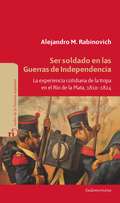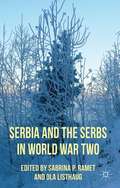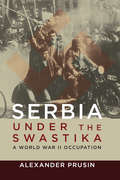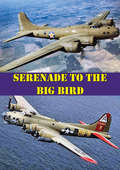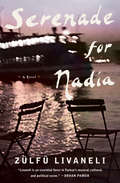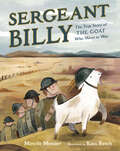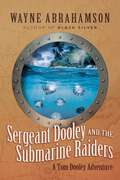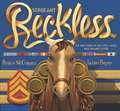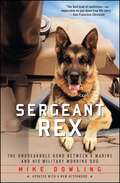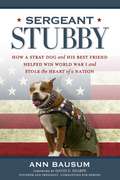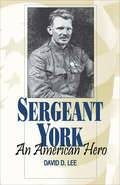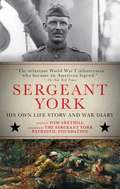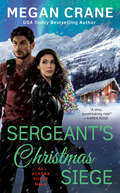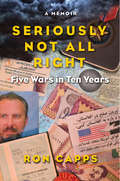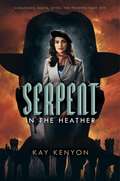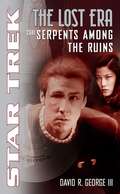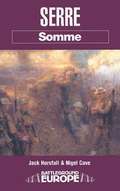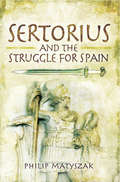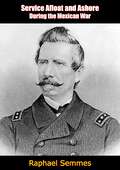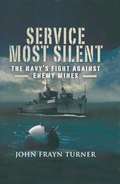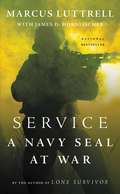- Table View
- List View
Ser soldado en las guerras de independencia: La experiencia cotidiana de la tropa en el Río de la Plata, 1810 - 1824
by Alejandro RabinovichLa vida cotidiana de los soldados en los ejércitos de la Independencia,por primera vez investigada a fondo y relatada de modo accesible yameno: cómo comieron, cómo durmieron, cómo lucharon. Para recuperar unaparte del sentido con el que una generación se sacrificó en los camposde batalla. Gracias a la educación escolar, cuando los argentinos pensamos en lasGuerras de Independencia pensamos ante todo en San Martín cruzando losAndes, en Belgrano izando la bandera en Rosario, en Brown dirigiendo laescuadra. Son guerras de generales y almirantes que implican yreproducen una cierta imagen del poder, de la política y de la historia.De esta manera, la tropa no aparece más que en contadísimos episodioscoreografiados, clásicos, salvados para la posteridad por su valoredificante: Cabral en San Lorenzo, el negro Falucho en el Callao, nomucho más. La Historia recoge exclusivamente sus últimos momentos, sumuerte heroica y abnegada, como si los soldados rasos no fuesen buenossino para morir, y ya que de morir se trata, morir contentos. Estelibro, en cambio, se interesa por cómo vivieron esos soldados. Cómocomieron, cómo durmieron, cómo lucharon. Con la idea de que alreconstruir su vida cotidiana podamos tal vez recuperar una parte delsentido con el que una generación se sacrificó en los campos de batalla.
Serbia and the Serbs in World War Two
by Sabrina P. Ramet Ola ListhaugA valuable and objective reassessment of the role of Serbia and Serbs in WWII. Today, Serbian textbooks praise the Chetniks of Draža MIhailovi? and make excuses for the collaboration of Milan Nedi?'s regime with the Axis. However, this new evaluation shows the more complex and controversial nature of the political alliances during the period.
Serbia under the Swastika: A World War II Occupation
by Alexander PrusinThe 1941 Axis invasion of Yugoslavia initially left the German occupiers with a pacified Serbian heartland willing to cooperate in return for relatively mild treatment. Soon, however, the outbreak of resistance shattered Serbia's seeming tranquility, turning the country into a battlefield and an area of bitter civil war. Deftly merging political and social history, Serbia under the Swastika looks at the interactions between Germany's occupation policies, the various forces of resistance and collaboration, and the civilian population. Alexander Prusin reveals a German occupying force at war with itself. Pragmatists intent on maintaining a sedate Serbia increasingly gave way to Nazified agencies obsessed with implementing the expansionist racial vision of the Third Reich. As Prusin shows, the increasing reliance on terror catalyzed conflict between the nationalist Chetniks, communist Partisans, and the collaborationist government. Prusin unwraps the winding system of expediency that at times led the factions to support one-another against the Germans--even as they fought a ferocious internecine civil war to determine the future of Yugoslavia.
Serenade To The Big Bird: A New Edition Of The Classic B-17 Tribute (Schiffer Military History Ser.)
by Bert StilesAfter completing a tour of duty (thirty-five missions) in B-17s, Bert Stiles transferred to a fighter squadron. Just four months later he was killed in action on an escort mission to Hanover, Germany, on November 26, 1944. Stiles' book was written in the period between his two tours. Serenade to the Big Bird portrays the tragedy of war, and specifically the loss to the world of a fine, sensitive, talented writer who had only a short time to prove his merit. He died at twenty-three.
Serenade for Nadia: A Novel
by Zülfü LivaneliIn this heartbreaking Turkish novel based on the real-life sinking of a refugee ship during World War II, an elderly professor leaves America to revisit the city where he last glimpsed his beloved wife. Istanbul, 2001. Maya Duran is a single mother struggling to balance a demanding job at Istanbul University with the challenges of raising a teenage son. Her worries increase when she is tasked with looking after the enigmatic Maximilian Wagner, an elderly German-born Harvard professor visiting the city at the university's invitation. Although he is distant at first, Maya gradually learns of the tragic circumstances that brought him to Istanbul sixty years before, and the dark realities that continue to haunt him. Inspired by the 1942 Struma disaster, in which nearly 800 Jewish refugees perished after the ship carrying them to Palestine was torpedoed off the coast of Turkey, Serenade for Nadia is both a poignant love story and a gripping testament to the power of human connection in crisis.
Sergeant Billy: The True Story of the Goat Who Went to War
by Mireille MessierA delightful tale inspired by the true story of a brave goat war hero. Perfect for fans of Finding Winnie and Rescue and Jessica. During World War I, a goat named Billy was adopted by a platoon of soldiers and made his way across the ocean to be part of the war effort.Billy . . .Trained with the soldiersWas smuggled across the oceanGot snuck into the frontlines in a box of orangesAte some secret documents and was arrested for treasonGot trench footHead-butted soldiers into a trench and saved them from a shellCame back home a decorated war heroThis charming true story follows Sergeant Billy from his small prairie town to the trenches of World War I and back, through harrowing moments, sad moments, moments of camaraderie and moments of celebration. This unforgettable goat and the platoon that loved him will capture your heart!
Sergeant Darling
by Bonnie GardnerMission Impossible?Nurse Patsy Pritchard wears her hospital uniform like camouflage gear, hiding a lonely heart she's declared off-limits to the men who try to get close. Then her eccentric aunt concocts a campaign with a handsome sergeant in mind, and Patsy knows her conflicts will only get worse-unless there's an unconditional surrender.Ray Darling has seen his share of hot spots and tough places, but getting through to the lovely blue-eyed blonde may be the hardest challenge yet. And just when his hopes appear to be more than dreams, he's sent overseas-and the gulf between him and Patsy is wider than ever....When two people are caught up in their own private wars, they just might need unconventional tactics to conquer the obstacles ahead!
Sergeant Dooley and the Submarine Raiders
by Wayne AbrahamsonAn ex-sergeant and a decorated combat veteran of America&’s Polar Bear Expedition to Russia, nineteen-year-old Thomas Dooley fought through a brutal winter against Red Russians only to find himself stranded in post-World War I Shanghai. With just over fifty dollars in his pocket, second-hand clothing on his back, and a beat-up Thompson submachine gun in a battered suitcase, he isn&’t sure how he will make it back to the US.To earn his passage home, Dooley finds work on an ex-Russian submarine. He leaves Shanghai under the leadership of Major Dimitri Utkin on a mission that he knows little about. Also on board are others who seek escape—from the dissatisfied captain of a U.S. Navy destroyer, whose chief petty officer is on the hunt for a chest of pirated British gold sovereigns, to a young and destitute Russian countess, Zeta Tolstoy. Dooley&’s expectations are complicated when he realizes that Utkin&’s cadre consists of men traumatized by the war and the Bolshevik Revolution—men who plan to impose their will on America. Before he knows it, Dooley&’s one-week commitment turns into a life-or-death struggle in the depths of the Pacific Ocean.
Sergeant Reckless (Animals to the Rescue #2)
by Emma Carlson BerneThe legendary tale of Sergeant Reckless comes to life in this heavily illustrated nonfiction chapter book series perfect for fans of Ranger in Time!Born to be racehorse in Seoul, Korea, Reckless was always destined for greatness. Then the Korean War began in 1950, and those dreams were dashed. But when Reckless was bought by a group of US Marines to work on the frontlines, it quickly became clear that this little mare had the heart of a hero.This action-packed series explores the stories of real-life animal heroes who saved the day! With black-and-white art throughout and dramatic storytelling, readers are taken on an exciting journey they won't soon forget.Fans of Ranger in Time will devour these true tales of incredible animal heroes!
Sergeant Reckless: The True Story of the Little Horse Who Became a Hero
by Iacopo Bruno Patricia McCormick<p>The inspiring true story of Reckless, the brave little horse who became a Marine. <p>When a group of US Marines fighting in the Korean War found a bedraggled mare, they wondered if she could be trained to as a packhorse. They had no idea that the skinny, underfed horse had one of the biggest and bravest hearts they’d ever known. And one of the biggest appetites! <p>Soon Reckless showed herself more than willing to carry ammunition too heavy for the soldiers to haul. As cannons thundered and shells flew through the air, she marched into battle—again and again—becoming the only animal ever to officially hold military rank—becoming Sgt. Reckless—and receive two Purple Hearts.</p>
Sergeant Rex: The Unbreakable Bond Between a Marine and His Military Working Dog
by Mike DowlingThe thrilling and inspiring story of a US Marine and his dog Rex, a bomb sniffing German Shepard, who forged a bond of trust and loyalty while serving on the war-torn streets of Iraq&’s most dangerous city.In Iraq we put our lives in each other&’s hands (and paws) day after day. We took care of each other no matter what. Rex and I have a bond that will last for the rest of our born days. If ever there was a marine who lived up to Semper Fidelis, the motto of the Marine Corps, it&’s Rex.Deployed to Iraq&’s infamous Triangle of Death in 2004, Sergeant Mike Dowling and his military working dog Rex were part of the first Marine Corps military K9 teams sent to the front lines of combat since Vietnam. It was Rex&’s job to sniff out weapons caches, suicide bombers, and IEDs, the devastating explosives that wreaked havoc on troops and civilians alike. It was Mike&’s job to lead Rex into the heart of danger time and time again, always trusting Rex to bring them both back alive. Dowling had turned twenty-five and Rex three just after they arrived in Iraq. Neither of them had any idea what to expect, and no training could fully prepare them for this job. An animal lover since childhood, Dowling had fostered and trained dogs for Guide Dogs for the Blind, and he was determined to serve in the military&’s K9 unit after joining the Marines. On their first patrols in Iraq, Rex suffered a seemingly incurable fear of explosions and gunfire, but with Mike at the other end of his leash, Rex gained the courage to perform his duty. Filled with harrowing tales of knife-edge bomb-detection work, including an extraordinary baptism by fire, Sergeant Rex is a heart-pounding account of how an unbreakable human-canine bond helped Mike and Rex to stay focused on their mission and save countless lives. Dowling takes us into the searing 130-degree heat, the choking dust, and the ever-present threat of violent attack that seemed to permeate Iraq&’s streets. We experience Dowling&’s visceral fear of walking down an IED-laden alley where dismemberment or death can come with any footstep, only his trusted partner, Rex, by his side. Loyalty is one of the hallmarks of any good Marine, and nowhere is that quality more evident than in this astonishing account of Mike Dowling and Rex&’s wartime experiences. A moving story of how a man and a dog developed complete trust in each other in the face of terrible adversity, Sergeant Rex is an unforgettable tale of sacrifice, courage, and love.
Sergeant Stubby: How a Stray Dog and His Best Friend Helped Win World War I and Stole the Heart of a Nation
by Ann Bausum David E. SharpeStubby's story begins in 1917 when America is about to enter the war. A stowaway dog befriends Private James Robert "Bob" Conroy at the Connecticut National Guard camp at Yale University and the two become inseparable. Stubby also wins over the commanding officer and is soon made an official member of the 102nd Infantry of the 26th division. What follows is an epic tale of how man's best friend becomes an invaluable soldier on the front lines and in the trenches, a decorated war hero and an inspiration to a country long after the troops returned home.
Sergeant York: An American Hero
by David D. LeeA stirring account of the heroic World War I exploits and life of Tennessean Alvin C. York. &“Reads like a good novel.&” —Southern Living In a brief encounter on October 8, 1918, during the Argonne offensive, Alvin C. York killed 25 German soldiers and, almost singlehandedly, effected the capture of 132 others. Returning to the United States the following spring, he received a tumultuous public welcome and a flood of offers from businessmen eager to capitalize on his acclaimed feat. But York, true to his character, went quietly back to his home in the Tennessee mountains, where he spent the remainder of his life working to bring schools and other services to those remote valleys where his neighbors lived. In this definitive biography, David D. Lee goes beyond that single wartime episode, however, to consider its consequences on York&’s later life—his efforts, not always successful, to better his mountain community; his involvement in making a motion picture of his life; his difficulties with money and taxes. But Sergeant York is better known as a symbol than as an individual, and in this study Lee connects the man and his life to an American heroic ideal. With his rural background, his refusal to take commercial advantage of his fame, and his simple piety, Alvin York exemplified the traditional values of an agrarian America that was in his own day already receding into the past. He claimed a special place in the hearts of his countrymen, Lee concludes, because his life seemed to show that the virtues of the common man continued to be a vital part of American society.
Sergeant York: His Own Life Story and War Diary
by Alvin YorkOctober 8th, 1918—amid the last of the Allies attempts to the Germans, Sergeant Alvin York of Tennessee, found himself and his platoon of only seventeen men trapped in the thick of heavy machine gun fire. Rather than retreating or calling upon the artillery to take out the nest, York single-handedly took out twenty-five Germans, dropping them one-by-one, and captured many more. This is only one of the many tales of York’s famed heroism, which were heralded as some of the most impressive battle stories in history of modern warfare. Sergeant York contains the legendary soldier’s war diaries, which offer up-close snapshots of his fabled military career. Included in this new edition of a classic work are new forewords written by York’s son and grandson, which provide both personal and historical recollections of their predecessor. In Sergeant York, experience the fascinating life of an American hero.
Sergeant's Christmas Siege (An Alaska Force Novel #3)
by Megan CraneDanger lurks in the wilds of Grizzly Harbor this Christmas but it's love that has Alaska Force in the cross-hairs, from the USA Today bestselling author of Sniper's Pride. When straight-arrow, by-the-rules Alaskan State Trooper Kate Holiday is sent to investigate a local band of secretive commandos in remote Grizzly Harbor over the holidays, her least favorite time of year, her objective is clear: disband Alaska Force and arrest them. But Kate didn't count on the diabolical temptation of Templeton Cross. The former Army Ranger exudes charm and has absolutely no respect for the rules of law that govern Kate's life - too bad he also makes her mouth water and her knees weak. Templeton has always been good at keeping his game face on and his emotions hidden, especially in combat. But working with Kate brings back memories of losses he prefers to keep locked up tight. As the pressure mounts - and Christmas draws closer - it’s a given that someone's going to get hurt. Trouble is, the more time he spends convincing his careful, wary trooper that there’s more to the holidays than her memories, the more he wants to keep her around. Forever. But forever is the one thing a man like Templeton can't do. Not even at Christmas.
Seriously Not All Right: Five Wars in Ten Years
by Ron CappsFor more than a decade, Ron Capps, serving as both a senior military intelligence officer and as a Foreign Service officer for the U.S. Department of State, was witness to war crimes, ethnic cleansing, and genocide. From government atrocities in Kosovo, to the brutal cruelties perpetrated in several conflicts in central Africa, the wars in both Aghanistan and Iraq, and culminating in genocide in Darfur, Ron acted as an intelligence collector and reporter but was diplomatically restrained from taking preventative action in these conflicts. The cumulative effect of these experiences, combined with the helplessness of his role as an observer, propelled him into a deep depression and a long bout with PTSD, which nearly caused him to take his own life. Seriously Not All Right is a memoir that provides a unique perspective of a professional military officer and diplomat who suffered (and continues to suffer) from PTSD. His story, and that of his recovery and his newfound role as founder and teacher of the Veterans Writing Project, is an inspiration and a sobering reminder of the cost of all wars, particularly those that appeared in the media and to the general public as merely sidelines in the unfolding drama of world events.
Serpent in the Heather (A Dark Talents Novel)
by Kay KenyonNow officially working for the Secret Intelligence Service, Kim Tavistock is back to solve another mystery—this time a serial killer with deep Nazi ties—in the sequel to At the Table of Wolves.Summer, 1936. In England, an assassin is loose. Someone is killing young people who possess Talents. As terror overtakes Britain, Kim Tavistock, now officially employed by England’s Secret Intelligence Service, is sent on her first mission: to the remote Sulcliffe Castle in Wales, to use her cover as a journalist to infiltrate a spiritualist cult that may have ties to the murders. Meanwhile, Kim’s father, trained spy Julian Tavistock runs his own parallel investigation—and discovers the terrifying Nazi plot behind the serial killings. Cut off from civilization, Sulcliffe Castle is perched on a forbidding headland above a circle of standing stones only visible at low tide. There, Kim shadows a ruthless baroness and her enigmatic son, plying her skills of deception and hearing the truths people most wish to hide. But as her cover disguise unravels, Kim learns that the serial killer is closing in on a person she has grown to love. Now, Kim must race against the clock not just to prevent the final ritual killing—but to turn the tide of the looming war.
Serpents Among the Ruins: The Lost Era 2311 (Star Trek: The Next Generation #2)
by David R. George IIIDiscover the astonishing story of an infamous and deadly confrontation with this thrilling original Star Trek novel. The year is 2311, a year of infamy for the United Federation of Planets. It is the year of the Tomed Incident, and its tale can at last be told. In the midst of escalating political tensions among the Klingons, the Romulans, and the Federation, Starfleet goes forward with the inaugural flight of the Starship Universe, a prototype that promises to revolutionize space exploration. But the Universe experiment results in disaster, ravaging a region of space dangerously close to the Romulan Star Empire, apparently confirming suspicions that the Federation has begun testing a weapon of mass destruction. As the military buildup accelerates on both sides of the Neutral Zone, Captain John Harriman of the Federation flagship Enterprise NCC-1701-B is fated for a final confrontation with his oldest enemy at a flashpoint in history—with the Beta Quadrant one wrong move from the outbreak of total war.
Serre: Somme (Battleground Europe)
by Nigel Cave Jack HorsfallThe tiny French hamlet of Serre is the subject of this guide. It covers four battles for the high ground upon which Serre is situated: June 1915: July 1916: November 1916 and July and August 1918.
Sertorius and the Struggle for Spain
by Philip MatyszakThe epic battle to liberate Spain from Roman rule is a masterclass of ancient guerilla warfare, recounted by the author of Ancient Rome on 5 Denarii a Day. In the year 82 BC, after a brutal civil war, the dictator Sulla took power in Rome. But among those who refused to accept his rule was the young army officer Quintus Sertorius. Sertorius fled, first to Africa and then to Spain, where he made common cause with the native people who had been savagely oppressed by a succession of corrupt Roman governors. Discovering a genius for guerilla warfare—and claiming to receive divine guidance from Artemis—Sertorius came close to driving the Romans out of Spain altogether. Rome responded by sending reinforcements under the control of Gen. Gnaeus Pompeius Magnus, who would go on to become Pompey the Great. The epic struggle between these two commanders, known as the Sertorian War, is a masterclass of ancient strategy and tactical maneuver. Massively outnumbered, Sertorius remained undefeated on the battlefield, but was eventually assassinated by jealous subordinates, none of whom proved a match for Pompey. The tale of Sertorius is both the story of a people struggling to liberate themselves from oppressive rule, and the story of a man who started as an idealist and ended almost as savage and despotic as his enemies. But above all, it is the story of a duel between two great generals, fought between two different styles of army in the valleys of the Spanish interior.
Servant of the American Nation
by Charles F. BrowerAs historian and biographer Mark Stoler has observed, the extraordinary career of George C. Marshall in the first half of the twentieth century paralleled the emergence of the United States as a great power. Indeed, this great servant-leader contributed substantively to virtually every important event and issue comprising that ascendance. Bringing together a who's who of Marshall scholars, this volume examines the major roles assumed by Marshall over his five-decade career - Soldier; Statesman and Peacemaker; and Leader and Manager - to illuminate key issues and themes surrounding the man and his era.
Service Afloat and Ashore During the Mexican War
by Raphael SemmesPublished in 1851, this is the history of and personal experiences of then, Lt. Raphael Semmes, U.S.N. Semmes, during the Mexican War. Semmes would later become the Captain of the infamous Confederate ship, the C.S.S. Alabama during the Civil War.-Print ed.Contains details of the battles of Mexico, and a survey of the line of operation of the U.S. Army, under the command of major-general Winfield Scott in 1847.
Service Industries Marketing: New Approaches
by Mark Gabbott Gillian HoggThis book covers a wide spectrum of topics, service contexts and methodologies and reflects the broad range of current services research. Its aim is to provide an eclectic overview of services marketing by including papers that demonstrate the breadth and depth of research in this area, and it reflects the international scope and the strength of the discipline as we enter the new millennium.
Service Most Silent: The Navy's Fight Against Enemy Mines
by John Frayn TurnerFrom the very outset of war Nazi Germany demonstrated its determination and ability to lay siege to the British Isles by the laying of mines in shipping lanes. Losses to both merchant ships and naval vessels became a serious factor. If supplies continued to be lost by a combination of U-Boat and mine attacks the very survival of the nation was at risk. Finding counter-measures to the German mine offensive was thus a top priority. The responsibility for this vital work rested with a small group of highly skilled and courageous naval specialists based at HMS Vernon, the RN's mine and torpedo shore-base at Portsmouth. Ranged against them was a growing and ingenious array of weapons: magnetic, acoustic, oyster, booby-trap mines to name but four varieties. Some were laid by boat, others dropped from the air. The story of HMS Vernon's contribution led by men such as Commander JGD Ouvry DSO and Captain R L Lewis DSO and many other courageous figures has been written by John Frayn Turner, the distinguished historian who served with them.He adopts a fast moving style to describe the near continuous struggle to detect, understand and master the best efforts of the German war machine. He brings home the constant deadly danger faced by these highly skilled and dedicated men.
Service: A Navy SEAL at War
by Marcus Luttrell James D. HornfischerNavy SEAL Marcus Luttrell returned from his star-crossed mission in Afghanistan with his bones shattered and his heart broken. So many had given their lives to save him-and he would have readily done the same for them. As he recuperated, he wondered why he and others, from America's founding to today, had been willing to sacrifice everything-including themselves-for the sake of family, nation, and freedom.In Service, we follow Marcus Luttrell to Iraq, where he returns to the battlefield as a member of SEAL Team 5 to help take on the most dangerous city in the world: Ramadi, the capital of war-torn Al Anbar Province. There, in six months of high-intensity urban combat, he would be part of what has been called the greatest victory in the history of U.S. Special Operations forces. We also return to Afghanistan and Operation Redwing, where Luttrell offers powerful new details about his miraculous rescue. Throughout, he reflects on what it really means to take on a higher calling, about the men he's seen lose their lives for their country, and the legacy of those who came and bled before.A thrilling war story, Service is also a profoundly moving tribute to the warrior brotherhood, to the belief that nobody goes it alone, and no one will be left behind.
